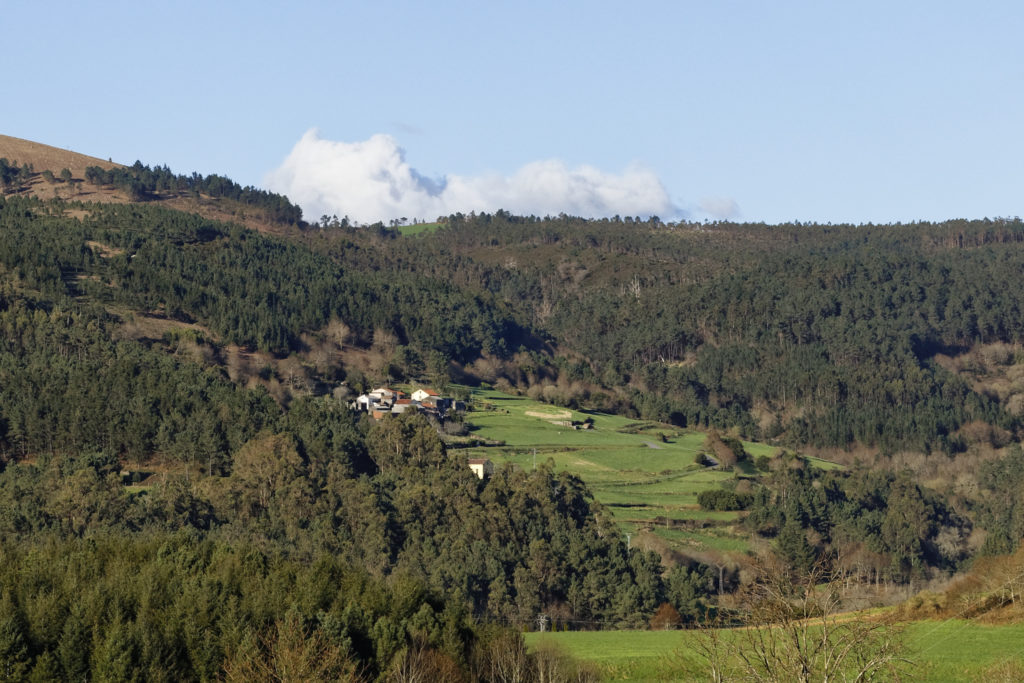
Study cases (II): Froxán Communal Forest
Froxán (Lousame) is a village marked by the fact that it is one of three that were occupied at the end of the 19th century by the San Finx mines. The importance of minerals such as tungsten for the manufacture of warfare munitions led to the occupation of common land and the denial of its management to the local population, who in return had access to jobs in the mine.
The communal forest, that now covers slightly more than 100 hectares was, like most, usurped by the State for repopulation in the 1940s, first with pine and later with eucalyptus. This forced the local population to dispose of a large part of their livestock, mainly sheep, which used to graze in the woodland.
A distinctive feature of this community is its size. It is formed by only around 5 houses with their corresponding attached vegetable garden and their surrounding communal forest. The community has hardly changed since its recognition as a communal forest in the 1970’s, which continued with a productivist model around the forest’s exploitation, inherited from Franco’s forest policies. In 2006, after a large fire, the community decided to change the way of exploiting the forest. Parts of the forest that were removed and strips of hardwood were reintroduced. This stopped the advance of another large fire that threatened the village 10 years later.
The tree plantations promoted by the State in the 1940s, first with pine and later with eucalyptus, forced the local population to dispose of a large part of their livestock, mainly sheep, which used to graze in the woodland.
Recovering the logic of the forest prior to its usurpation in the 1940s, the community opted for a long-term strategy based on diversifying the plantation by introducing the most suitable varieties for each particular place. This process is supported through volunteer work by means of “a roga e o albaroque” (“beg and feast”). People from outside the community are invited to participate, in the elimination of the shoots of invasive species and the planting of the desired species (roga). In return, after the working day, everyone receives food and drink together (albaroque). This initiative became the germ of the now famous “diseucalyptation brigades”, in collaboration with the ecologist association Verdegaia. These brigades are now made up of hundreds of people who carry out this type of action in other parts of Galicia.
In 2006, after a large fire, the community decided to change the way of exploiting the forest. Parts of the forest that were removed and strips of hardwood were reintroduced. This stopped the advance of another large fire that threatened the village 10 years later.
The desire to convert the forest into a sustainable space also brought environmental education to children on the ground. This is how the association “Montescola” (“Forestchool”) was born in Froxán. At the same time they developed the Centre of Knowledge for Sustainability, officially recognized by the United Nations at the 12th Meeting of the Ubuntu Committee of Peers for the RCEs (Okayama, Japan, 4 December 2017). This path of internationalisation is corroborated by the inclusion of the community in the catalogue of ICCAs “Territories and Areas Conserved by Indigenous Peoples and Local Communities”.
Froxán is a typical communal forest that knew how to take advantage of its added value and achieve social and institutional recognition motivated by good work around ecology and sustainability.
Froxán is a typical communal forest that knew how to take advantage of its added value and achieve social and institutional recognition motivated by good work around ecology and sustainability. Through the Ecosocial Lab we will learn from exemplary experiences and we will investigate the logic of the management that took place in the past in other communities such as Laíño and Baroña, to continue building a more sustainable territory.
Related posts







